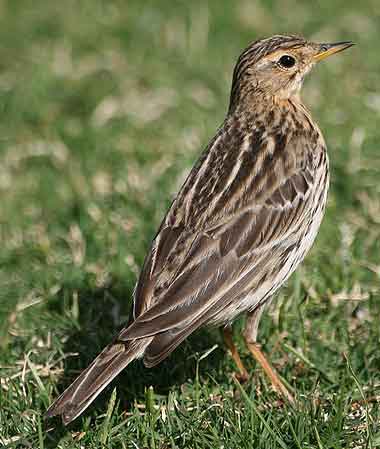
Anthus cervinus
Superregnum: Eukaryota
Cladus: Unikonta
Cladus: Opisthokonta
Cladus: Holozoa
Regnum: Animalia
Subregnum: Eumetazoa
Cladus: Bilateria
Cladus: Nephrozoa
Superphylum: Deuterostomia
Phylum: Chordata
Subphylum: Vertebrata
Infraphylum: Gnathostomata
Megaclassis: Osteichthyes
Cladus: Sarcopterygii
Cladus: Rhipidistia
Cladus: Tetrapodomorpha
Cladus: Eotetrapodiformes
Cladus: Elpistostegalia
Superclassis: Tetrapoda
Cladus: Reptiliomorpha
Cladus: Amniota
Classis: Reptilia
Cladus: Eureptilia
Cladus: Romeriida
Subclassis: Diapsida
Cladus: Sauria
Infraclassis: Archosauromorpha
Cladus: Crurotarsi
Divisio: Archosauria
Cladus: Avemetatarsalia
Cladus: Ornithodira
Subtaxon: Dinosauromorpha
Cladus: Dinosauriformes
Cladus: Dracohors
Cladus: Dinosauria
Ordo: Saurischia
Cladus: Eusaurischia
Subordo: Theropoda
Cladus: Neotheropoda
Cladus: Averostra
Cladus: Tetanurae
Cladus: Avetheropoda
Cladus: Coelurosauria
Cladus: Tyrannoraptora
Cladus: Maniraptoromorpha
Cladus: Maniraptoriformes
Cladus: Maniraptora
Cladus: Pennaraptora
Cladus: Paraves
Cladus: Eumaniraptora
Cladus: Avialae
Infraclassis: Aves
Cladus: Euavialae
Cladus: Avebrevicauda
Cladus: Pygostylia
Cladus: Ornithothoraces
Cladus: Ornithuromorpha
Cladus: Carinatae
Parvclassis: Neornithes
Cohors: Neognathae
Cladus: Neoaves
Cladus: Telluraves
Cladus: Australaves
Ordo: Passeriformes
Subordo: Passeri
Infraordo: Passerida
Superfamilia: Passeroidea
Familia: Motacillidae
Genus: Anthus
Species: Anthus cervinus
Name
Anthus cervinus (Pallas, 1811)
Synonymy
Motacilla cervina (protonym)
References
Zoographia Rosso-Asiatica 1: 511.
Vernacular names
Afrikaans: Rooikeelkoester
العربية: جشنة حمراء الحنجرة
български: Червеногуша бъбрица
भोजपुरी: एंथस सर्विनस
brezhoneg: Sidan gouzoug ruz
català: Piula gola-roja
čeština: Linduška rudokrká
Cymraeg: Corhedydd gyddfgoch
dansk: Rødstrubet piber
Deutsch: Rotkehlpieper
Ελληνικά: Κοκκινοκελάδα
English: Red-throated Pipit
Esperanto: Ruĝgorĝa pipio
español: Bisbita gorgirrojo
eesti: Tundrakiur
فارسی: پیپت گلوسرخ
suomi: Lapinkirvinen
føroyskt: Reyðtítlingur
français: Pipit à gorge rousse
galego: Pica de gorxa rubia
עברית: פיפיון אדום-גרון
magyar: Rozsdástorkú pityer
հայերեն: Կարմրախածի ձիաթռչնակ
日本語: ムネアカタヒバリ
қазақша: Қызылтөс жадырақ
lietuvių: Rudagurklis kalviukas
latviešu: Sarkanrīkles čipste
македонски: Црвеногушеста треперка
монгол: Зосонгүеэ шийхнүүхэй
Bahasa Melayu: Burung Ciak Leher Merah
नेपाली: लालकण्ठे चुइयाँ
Nederlands: Roodkeelpieper
norsk: Lappiplerke
polski: Świergotek rdzawogardły
português: Petinha-de-garganta-ruiva
русский: Краснозобый конёк
slovenčina: Ľabtuška červenohrdlá
svenska: Rödstrupig piplärka
Türkçe: Kızıl gerdanlı incir kuşu
українська: Щеврик червоногрудий
Tiếng Việt: Manh họng đỏ
中文: 红喉鹨
The red-throated pipit (Anthus cervinus) is a small passerine bird,which breeds in the far north of Europe and the Palearctic, with a foothold in northern Alaska. It is a long-distance migrant, moving in winter to Africa, South and East Asia and the West Coast United States. It is a vagrant to Western Europe.
Etymology
The scientific name is from Latin. The generic name Anthus is the name for a small bird of grasslands, and the specific name cervinus means "stag-coloured", from cervus, "stag".[2]
Description
This is a small pipit, with an adult easily identified in the breeding season by its brick-red face and throat. In other plumages, this is an undistinguished-looking species, heavily streaked brown above, with whitish mantle stripes, and with black markings on a white background below. It is very similar in appearance to the meadow pipit, and in the autumn, it much resembles the tree pipit, but has an altogether more striped appearance because of the larger numbers of streaks on the cap, back, flank, rump, and chest. The flight of the red-throated pipit is strong and direct, and it gives a characteristic psii call as it flies.[3]
Behaviour
The red-throated pipit is native to the boreal regions of Northern Europe and Asia. The breeding habitat is open country including mountains, marshland, and tundra. The nest is built on the ground, often beside a tussock of grass, on rough grassland, or on a hummock in a marsh. It is made of dry grasses and sedges with a soft lining of reindeer hair or down. Four to six eggs are laid and incubated by the female for nearly two weeks. The young are fledged and ready to leave the nest about 12 days later. The red-throated pipit is insectivorous, like its relatives, but also eats seeds.[3]
Status
The red-throated pipit has a very large range and the global population has been estimated to be about two million individuals. It is rated as being of least concern by the IUCN, as its population is believed to be stable, and it faces no particular threats.[4]
References
BirdLife International (2019). "Anthus cervinus". IUCN Red List of Threatened Species. 2019: e.T22718560A137415441. doi:10.2305/IUCN.UK.2019-3.RLTS.T22718560A137415441.en. Retrieved 12 November 2021.
Jobling, James A. (2010). The Helm Dictionary of Scientific Bird Names. London, United Kingdom: Christopher Helm. pp. 49, 97. ISBN 978-1-4081-2501-4.
"Red-throated Pipit: Anthus cervinus". NatureGate. Retrieved 2013-12-13.
"Species factsheet: Anthus cervinus". BirdLife International. Retrieved 2013-12-13.
Retrieved from "http://en.wikipedia.org/"
All text is available under the terms of the GNU Free Documentation License

